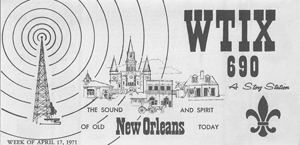Images
of America
New
Orleans Radio
From humble beginnings in a physics lab on the campus of Loyola University came the sounds of the first radio station in the lower Mississippi River Valley, when WWL Radio signed on in 1922. That little station would grow into a national powerhouse, with its morning Dawnbusters show and nightly broadcasts from the Blue Room of the Roosevelt Hotel. The city’s second oldest station, WSMB, with studios in the Maison Blanche Building, developed its own cast of favorites including Nut and Jeff. Later, in the city known as the birthplace of jazz, radio played a key role in popularizing early rock and roll. Disc jockeys at leading stations WTIX and WNOE helped develop the Crescent City sound, along with local personalities with colorful names like Poppa Stoppa, Jack the Cat and Dr. Daddy-O..
Author Dominic Massa is a native of the New Orleans area who works as the executive producer and special projects director at WWL-TV. A past president of the Press Club of New Orleans, he has written and produced numerous programs and features on broadcasting history, including two programs for the city’s PBS affiliate, WYES-TV: New Orleans TV: The Golden Age and Stay Tuned: New Orleans’ Classic TV Commercials. He is also the author of Images of America: New Orleans Television, also by Arcadia Publishing.
Paperback:
128 pages
Publisher: Arcadia Publishing (October 20, 2014)
Language: English
ISBN-10: 1467112429
ISBN-13: 978-1467112420
|
or
visit your local retail outlet

Originally from Laurel, Mississippi, James “Okey Dokey” Smith was the most popular disc jockey on WBOK when it signed on in the early 1950s. “Listen to Doke, all fire no smoke – knocked -out frantic jive,” is an example of how the station promoted his shows. There were actually several WBOK hosts to use the name “Okey Dokey” over the years, much like the “Poppa Stoppa” character.(Tex Stephens collection. |
 |

|
| Images
of America
New Orleans Radio Cover |

Vernon “Doctor Daddy-O” Winslow (right) interviews jazz clarinetist Barney Bigard on WWEZ Radio. The station, at 690 AM, was located in the Hotel New Orleans. The man to the left of the photo is unidentified. Despite his star status, Winslow said he was still forced to use the hotel’s freight elevator to get to the studio. (Co
urtesy of the New Orleans Jazz Club Collection of the Louisiana State Museum.)
|
|
|
| New Orleans Radio uses close to 200 archival photographs to trace the history of local radio from its earliest days in 1922, with memories of popular programs and personalities over the past 90 years. |
|
| Website
designed and Developed by Bachigraphics.com©2014 |